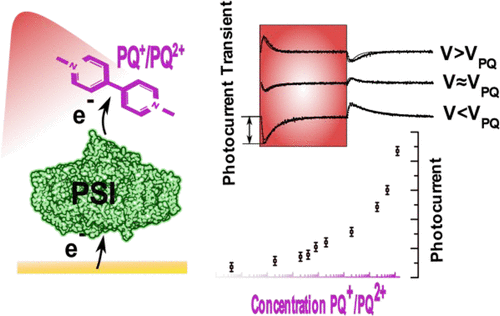Our official English website, www.x-mol.net, welcomes your
feedback! (Note: you will need to create a separate account there.)
Fast Photo-Chrono-Amperometry of Photosynthetic Complexes for Biosensors and Electron Transport Studies
ACS Sensors ( IF 8.2 ) Pub Date : 2021-02-16 , DOI: 10.1021/acssensors.1c00179 Manuel López-Ortiz 1, 2 , Ricardo A. Zamora 1, 2 , Maria Elena Antinori 1 , Vikas Remesh 3 , Chen Hu 4 , Roberta Croce 4 , Niek F. van Hulst 3, 5 , Pau Gorostiza 1, 2, 5
ACS Sensors ( IF 8.2 ) Pub Date : 2021-02-16 , DOI: 10.1021/acssensors.1c00179 Manuel López-Ortiz 1, 2 , Ricardo A. Zamora 1, 2 , Maria Elena Antinori 1 , Vikas Remesh 3 , Chen Hu 4 , Roberta Croce 4 , Niek F. van Hulst 3, 5 , Pau Gorostiza 1, 2, 5
Affiliation

|
Photosynthetic reactions in plants, algae, and cyanobacteria are driven by photosystem I and photosystem II complexes, which specifically reduce or oxidize partner redox biomolecules. Photosynthetic complexes can also bind synthetic organic molecules, which inhibit their photoactivity and can be used both to study the electron transport chain and as herbicides and algicides. Thus, their development, characterization, and sensing bears fundamental and applied interest. Substantial efforts have been devoted to developing photosensors based on photosystem II to detect compounds that bind to the plastoquinone sites of this complex. In comparison, photosystem I based sensors have received less attention and could be used to identify novel substances displaying phytotoxic effects, including those obtained from natural product extracts. We have developed a robust procedure to functionalize gold electrodes with photo- and redox-active photosystem I complexes based on transparent gold and a thiolate self-assembled monolayer, and we have obtained reproducible electrochemical photoresponses. Chronoamperometric recordings have allowed us to measure photocurrents in the presence of the viologen derivative paraquat at concentrations below 100 nM under lock-in operation and a sensor dynamic range spanning six orders of magnitude up to 100 mM. We have modeled their time course to identify the main electrochemical processes and limiting steps in the electron transport chain. Our results allow us to isolate the contributions from photosystem I and the redox mediator, and evaluate photocurrent features (spectral and power dependence, fast transient kinetics) that could be used as a sensing signal to detect other inhibitors and modulators of photosystem I activity.
中文翻译:

用于生物传感器和电子传输研究的光合复合物的快速光-计时-电流法
植物,藻类和蓝细菌中的光合作用反应是由光系统I和光系统II复合物驱动的,它们会特异性地还原或氧化伴侣氧化还原生物分子。光合复合物还可以结合合成有机分子,从而抑制其光活性,可以用于研究电子传输链,也可以用作除草剂和杀藻剂。因此,它们的开发,表征和传感具有根本的和应用的兴趣。已经致力于开发基于光系统II的光传感器,以检测与该复合物的质体醌位点结合的化合物。相比之下,基于光系统I的传感器受到的关注较少,可用于识别具有植物毒性作用的新型物质,包括从天然产物提取物中获得的物质。我们已经开发了一种健壮的程序,可以使用基于透明金和硫醇盐自组装单分子层的具有光和氧化还原活性的光系统I配合物使金电极功能化,并且已经获得了可重现的电化学光响应。计时安培记录使我们能够在锁定操作下,在浓度低于100 nM的紫罗兰衍生品百草枯存在的情况下,以及跨越六个数量级的最大100 mM传感器动态范围,测量光电流。我们已经对它们的时间过程进行了建模,以识别电子传输链中的主要电化学过程和限制步骤。我们的结果使我们能够隔离光系统I和氧化还原介体的贡献,并评估光电流特征(光谱和功率相关性,
更新日期:2021-02-26
中文翻译:

用于生物传感器和电子传输研究的光合复合物的快速光-计时-电流法
植物,藻类和蓝细菌中的光合作用反应是由光系统I和光系统II复合物驱动的,它们会特异性地还原或氧化伴侣氧化还原生物分子。光合复合物还可以结合合成有机分子,从而抑制其光活性,可以用于研究电子传输链,也可以用作除草剂和杀藻剂。因此,它们的开发,表征和传感具有根本的和应用的兴趣。已经致力于开发基于光系统II的光传感器,以检测与该复合物的质体醌位点结合的化合物。相比之下,基于光系统I的传感器受到的关注较少,可用于识别具有植物毒性作用的新型物质,包括从天然产物提取物中获得的物质。我们已经开发了一种健壮的程序,可以使用基于透明金和硫醇盐自组装单分子层的具有光和氧化还原活性的光系统I配合物使金电极功能化,并且已经获得了可重现的电化学光响应。计时安培记录使我们能够在锁定操作下,在浓度低于100 nM的紫罗兰衍生品百草枯存在的情况下,以及跨越六个数量级的最大100 mM传感器动态范围,测量光电流。我们已经对它们的时间过程进行了建模,以识别电子传输链中的主要电化学过程和限制步骤。我们的结果使我们能够隔离光系统I和氧化还原介体的贡献,并评估光电流特征(光谱和功率相关性,











































 京公网安备 11010802027423号
京公网安备 11010802027423号